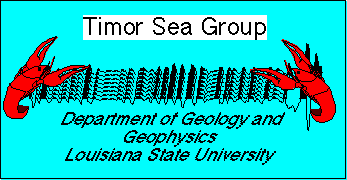(Geol 4068- Fall 2000)
Department of Geology and Geophysics
or
"... subsurface remote sensing "
Thu, Fri. 11.30-12.30 p.m. (~lectures)
Room E207, Howe-Russell Complex
Labs on Mondays from 3.30 p.m. - 6.30 p.m.
(~ labs, 2 field days acquiring data)
Room E217, Howe-Russell Complex

| Instructor: Juan M. Lorenzo
Office 215, Howe-Russell Complex (Old building) e-mail: juan@geol.lsu.edu URL: http:// tellus.geol.lsu.edu Office Hours: By appointment (8-4249) |
Homework:
Interactive seismic processing of a data set collected by students in the field and tutorial sets. This field trip is mandatory and essential to understand the course material. A full weekend in lat Spetmeber will be assigned for this purpose. If any student has difficulty with the arrangement they should countact me ASAP in the semester. Graduate students will have either separate homeworks which require critical analysis of key publications or additional problems to carry out as part of their course requirement. |
| Aim: Introduction to seismic data acquisition, processing and the limitations of seismic interpretation | Instructional Data Sets:
* High-resolution seismic data acquired during the course * Marine seismic data from a carbonate shelf, (NW Shelf of Australia) * Marine seismic data from a clastic, canyon-cut continental slope- (NJ Continental slope) * Stratigraphic sections and synthetic seismogram models |
| Instructional Class
notes on the web
and handouts Software In-house programs + SUnix - seismic processing software package from the Center for Wave Phenomena, Colorado School of Mines. 2D ProMAX-interactive Landmark state-of-the-art processing package. MacRay 1D modeling on the Macintosh |
Tests: Final letter grades are calculated using
the results of lab and homework exercises (70%) plus a final openbook
exam (30%).
On the final examyou will require a working understanding of ALL material covered during the course. Letter grades will reflect the following scores for students. It is understood that for graduate students enrolled in this course a C grade implies unacceptable academic performance. Except for outright F grades, for graduate students a C or D grade will be translated to a C on the final grade sheet. A (90-100%) , B (80-89.5%), C (60-79.5%) D (50-59.5%), F (less than 49.5%) |
| Note:
Please sign out key code for E217 from Joan Payne |
Pre-requisites:
Proficiency in fundamental Calculus and Physics Sweat and willingness to learn some Unix |
AUGUST
(Click SEISMIC
ACQUISITION to get more information on tools and procedures)
| Mon. 21
Tue. 22
Mon. 28
Tue 31 |
Organizational Meeting
Introduction to course requirements and computer lab
Vertical Resolution Fresnel Zone/Horizontal Resolution
|
SEPTEMBER
| Mon.4 (Labor Day )
Tue 5
Mon. 11 Tue 12 Mon. 18
Tue 19 Field Trip 9/23 Mon. 25
Tue 26 |
no class
CMP/CDP Method continued
Notch filters, First homework due Fourier Theory Spectral
Analysis and Band-Pass
filtering tutorials and handouts
for lab Homework on CMP,
spikes and
Raypaths and waves in the subsurface
no class, second homework due, Answers to
Critical angles, Reflection coefficients |
OCTOBER
| Mon. 2
Tue 3
5-6 Fall Holiday Mon. 9
Tue 10
Mon. 16
Tue 17
Mon. 23
Tue 24 Mon 30 Tue 31 |
Industry
Lecture
Mike Liebelt - MARATHON- Amplitude Analysis for Reserve Estimation- A Hands-on-exercise Geometric spreading, Attenuation, Automatic
Gain Control
Field Experiment-
Trace Reverse & spectrum analysis
RMS velocity, Constant velocity stacks
Field Experiment- Band Pass Filter & AGC Multiples
Field Experiment-Stacking
and
Migration, Diffraction Seismic Processing Project Snell's Law
|
NOVEMBER
| Mon. 6
Tue 7
Mon. 13 Tue 14
Mon. 20 23-24 Thanksgiving Holoday Mon. 27 Tue 28 |
Seismic Processing Project
Refractions, A,w,r,energy
of motionElastic constant
Seismic Processing Project No class- GSA meeting
Seismic Processing Project
Convolutional Model of the Earth and Synthetic Seismograms Synthetic seismograms |
DECEMBER
| Mon. 4 - Sat. 9 | FINAL EXAM |
|
* General theory Sheriff, R.E., and Geldart, L.P., 1995, Exploration Seismology v. New York, Cambridge University Press, 592 p. Bullen, K.E., and Bolt, B.A., 1987, An introduction to the theory of seismology (4 edition), v. Cambridge, Great Britain, Cambridge University Press, 499 p. * Dictionary Sheriff, R.E., 1981, Encyclopedic dictionary of exploration geophysics Tulsa, OK, Society of Exploration Geophysicists, 266 p. (WONDERFUL and REQUIRED) (On reserve at the libreary) Telford, W.M., Geldart, L.P., Sheriff, R.E., and Keys, D.A., 1986, Applied geophysics v. New York, Cambridge University Press, 860 p. * Seismic processing Processing near-surface seismic reflection data: A primer by Gregory S. Baker, 1999 (REQUIRED) Yilmaz, O., 1988, Seismic data processing Tulsa, Society of Exploration
Geophysicists, 526 p.
General Geophysics Stacey, F.D., 1977, Physics of the Earth v. New York, Johm Wiley and
Sons, 414 p.
General seismic processing Hatton, L., Worthington, M., and Makin, J., 1988, Seismic data processing: Theory and practice Blackwell, 177 p. |